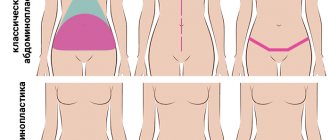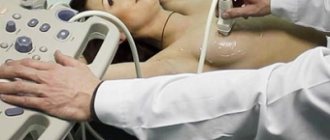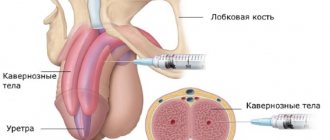What kind of pathology is this?
What is diastasis?
What kind of pathology is diastasis after childbirth? There is what is called the linea alba, located right in the center. This line is the point where the rectus abdominis muscles connect. With diastasis after childbirth, these muscles move apart from each other.
This happens in women after the birth of a child, because during pregnancy the growing uterus exerted strong pressure on the peritoneal space and abdominal muscles. Also, during the period of bearing a baby, the active production of the hormone relaxin occurs, which softens muscle fibers and joints, and this can lead to their excessive mobility. Not every woman returns to normal muscle tone after pregnancy, then a young mother can learn for the first time what muscle diastasis is.
This pathology occurs in approximately 35% of women who give birth, so it is important to carefully monitor the abdominal muscles after childbirth in order to identify a serious problem in time.
Important! This disease occurs more often in multiparous women, since with each subsequent pregnancy the muscles weaken.
Diastasis is most often observed in multiparous women.
Causes of diastasis
Childbirth is a difficult process during which the body experiences maximum stress. A high load falls on the abdominal muscles. They are also tested during pregnancy. The growing fetus and the uterus lead to stretching of the muscle tissue. Before childbirth, it is enhanced by a special state of the hormonal system. Relaxin, produced by the body to facilitate the process, makes the connective fibers weaker. They stretch more easily, but returning to their previous elastic state in the postpartum period is not so easy.
In the body of every pregnant woman and woman in labor, approximately the same biological reactions occur. But divergence of the rectus abdominis muscles after childbirth will occur in the following cases.
| Cause | Consequence |
| Multiple pregnancy | The volume of the uterus here is significantly larger, that is, the load on the tissue is higher. |
| Polyhydramnios | Excess amniotic fluid also increases the size of the reproductive organ, and therefore the pressure on the muscle wall, the connective tissue that connects its different parts. |
| Overweight | In this case, the pressure on the rectus muscles is bilateral, which cannot but negatively affect their condition and location. |
| Not the first birth | Previous pregnancy weakens the tissues of the abdominal wall. And if you don’t consciously set out to strengthen them, then problems cannot be avoided. But few people think about this, and when the time comes to bear subsequent children, the load falls on the initially weakened muscles. |
| Unfavorable heredity | The existence of a problem in the mother makes it more likely that the daughter, after giving birth, will experience the phenomenon of diastasis. |
Why does the discrepancy occur?
A woman who is faced with this disease may not fully understand the true cause of the disease. The disease can develop not only in pregnant women. Here are some reasons why muscle diastasis may develop:
- Incorrect distribution of physical activity when performing certain exercises.
- A prolonged viral infection, accompanied by a prolonged cough that strains the muscles.
- Unstable body weight, weight either falls or increases, as a result of which the muscles lose their normal tone.
- Weakness of the rectus abdominis muscles from birth.
The causes of stretched muscle fibers during pregnancy can be:
- Bearing several fruits.
- Excess amniotic fluid.
- The presence of a large fetus.
- Repeated pregnancy.
On a note! Experts say that stretching the abdominal muscles is a serious pathology and can lead to a number of complications, such as the formation of a hernia.
Diastasis can develop due to weak abdominal muscles
Possible complications and consequences
Abdominal muscle discrepancy is not a cosmetic problem. The disease has a tendency to progress. In addition to unpleasant symptoms, the disease threatens the patient with prolapse of the abdominal organs and disruption of their functioning.
Other consequences of rectus abdominis muscle separation after vaginal birth or cesarean section:
- connective tissue atrophy;
- tendon strain;
- loss of connective tissue ability to recover;
- umbilical hernia;
- risk of complications in the next pregnancy.
The discrepancy of the abdominal muscles not only changes the silhouette of a woman’s figure, but also leads to certain problems:
- inability to effectively push during natural childbirth;
- displacement of abdominal organs;
- improper distribution of the load on the spine, which leads to changes in posture and the development of various spinal diseases.
For these reasons, discrepancy of the rectus abdominis muscles during pregnancy must be identified and treated promptly. In most cases, after childbirth, women experience only aesthetic problems.
How to detect the disease in time?
A woman can detect this pathology in time if she knows the symptoms of diastasis well. These include the following conditions:
- Strong protrusion of the navel.
- Prolonged pain in the lumbar spine.
- Sagging belly after a long period of postpartum activity.
- The appearance of fat folds in the abdominal area, shaped like a roller.
If even 1-2 symptoms appear, one can suspect the presence of a discrepancy in the peritoneal muscles.
Here are a few actions that a woman can do to independently detect muscle pathology:
- It is necessary to take the “lying on your back” position. You should lie down on a hard surface.
- Bend your knees, place your feet firmly on the floor.
- The right hand should be placed behind the head, and the left hand should be placed on the abdominal area. Using the fingertips of your left hand, you should carefully but gently feel the area just above the navel or directly the umbilical area, and press lightly.
- If, when palpating, the fingers seem to have sunk, it means there is diastasis.
You can also feel the divergence of the rectus muscles by trying to lift the chest from the floor, and if a roller-like protrusion of the abdomen forms, then most likely this indicates a divergence of the muscles of the abdominal space.
If you know exactly how to determine diastasis, you can identify the disease in time and eliminate it.
A strongly protruding navel may be one of the symptoms of diastasis
Stages of divergence
In medical practice, there are several stages of diastasis:
- There is a slight discrepancy between the muscles (within 5-7 cm), the shape of the abdomen at this stage usually remains unchanged.
- Widening of the linea alba in the lower abdomen. This degree of diastasis makes the stomach slightly saggy from below.
- Severe muscle stretching along the entire length of the linea alba. It is reflected in the shape of the abdomen, it looks very protruded.
Depending on the severity of the stretch, the abdominal muscles can be brought into shape by performing certain exercises.
How to get rid of abdominal muscle strain?
Of course, if a pathology is detected, you should consult a specialist. Having identified the cause and compared it with the degree of health risk in the future, he can prescribe special exercises for diastasis. Typically a set of exercises is prescribed:
Exercise “Cat” for diastasis
- Bridge. A well-known exercise that every person performed. Lying on your back, you need to lift your pelvis off the floor and lift it up. You can repeat this exercise 10 times. During this exercise, the abdominal and thigh muscles are tensed.
- From the starting position “lying on your back,” you should raise your head and shoulders and stay in this position for a few seconds. You can repeat this exercise about 30 times.
- In the “lying on your back” position, you should alternately raise your legs until a right angle is formed with the body. The exercise can be repeated 10 times for each leg.
- Raising both legs bent at right angles.
- A well-known exercise called “Cat”. You need to kneel with your hands on the floor. Arch your back up and bend down, while trying to pull in your stomach.
- Doing squats. The starting position is “standing against the wall”, pressing tightly, creating an angle of 45 degrees from the wall to the feet. You should hold a small ball between your knees. When these requirements are met, you should begin squats until your thighs are parallel to the floor. This exercise can be repeated up to 20 times.
Performing this kind of gymnastics helps strengthen the abdominal muscles and will help get rid of postpartum diastasis. Such exercises for diastasis do not put excessive stress on the muscles, but contribute to effective recovery. In order for gymnastics to give the desired result, it should be performed regularly. It is also necessary to take breathing and abdominal contraction exercises seriously. During gymnastics, inhale through the nose and exhale through the mouth.
With initial and moderate severity of diastasis, performing a similar set of exercises effectively helps to cope with the disease. If the patient has the most severe form of muscle strain, then surgery can help, as there is a risk of developing serious complications to the internal organs.
Severe forms of the disease may require surgery
How to determine your muscle discrepancy
Normally, the distance between the right and left sections of the rectus muscles should be less than 2 - 2.5 cm. If the arrival of the baby caused a problem, it will be greater. Even when the difference from the norm is small, the pathological condition still exists. But identifying a tear in the abdominal muscles after childbirth is not always easy at first glance. After all, this part of the body in new mothers remains convex for quite a long time for objective reasons not related to diastasis.
Pain syndrome and other signs that can indicate it do not appear immediately, and they also occur with other diseases.
But there is a test that will help identify diastasis at an early stage. To do this you need to do the following:
- Determine the boundaries of the possible occurrence of the problem. This is the area from the lower lobe of the sternum to the navel.
- Lie horizontally with your knees bent. Feet should be on the floor.
- One hand should be placed behind the back of the head. The other should be placed on the stomach so that its white line is at a right angle to the fingers.
- Raising your shoulders slightly, you need to gently press on the linea alba of the abdomen, feeling its extreme boundaries. They are the rectus abdominis muscles. There should be no more than 2.5 cm between their edges.
If a woman has taken the correct position for self-examination, she will easily feel the discrepancy, if any, and even the size of the problem. When it amounts to:
- up to 7 cm – this is a mild degree of pathology;
- 7 - 10 cm - the average level of its development;
- over 10 cm – severe, requiring surgery.
What should you not do if you have diastasis?
Physical activity that is strictly prohibited if rectus muscle separation is suspected:
- It is forbidden to pump up the abs, as athletes do: raising straight legs up from a “lying on your back” position or lifting the upper body.
- You can't do push-ups.
- Do not perform exercises on your back using a fitball.
- Do not lift heavy objects.
Diastasis after childbirth can be eliminated by following simple recommendations. And if a woman contacts a specialist in time, she will be given the best recommendations on how to get rid of diastasis.
Prohibited exercises
How to avoid the problem?
Is it possible to somehow prevent the problem, rather than look for its solution? Of course, you can prevent and avoid many problems if you carefully take care of yourself and follow the recommendations of your doctor.
Following a number of simple rules will help a pregnant woman avoid harm to her health:
- Use products to support your back and abdominal muscles during pregnancy. These products include a prenatal bandage. They help reduce stress on the lumbar region and abdominal muscles and prevent their separation.
- Perform any physical activity correctly to avoid pressure on the peritoneal space.
- After the baby is born, it is best to wear a postpartum bandage to help the abdominal muscles return to normal tone.
- Water cures many diseases, so swimming is beneficial for everyone, especially pregnant women.
- If there are no contraindications, a pregnant woman can perform moderate physical activity or special gymnastics for pregnant women.
- Under no circumstances should you get out of bed from a “lying on your back” position, so as not to strain your already relaxed abdominal muscles. Lifting should be done from a lateral position of the body.
- Maintain your posture. One of the most important rules, since it is posture that helps strengthen and maintain back muscles during pregnancy.
- Sleeping on your stomach is not recommended. Being in this position places a lot of stress on the midline of the abdomen, and this can lead to muscle strain.
It is important to remember one thing: diastasis will not heal on its own; you need to make every effort to do so, or in more severe cases, remove it surgically.
During pregnancy, you should definitely use products to support your abdominal muscles.
Exercises to strengthen your abdominal muscles
Of course, it is best if the set of classes is compiled by an experienced instructor, taking into account individual characteristics, but there are several simple exercises that will help cope with muscle discrepancy in the initial stages.
- One of the most popular exercises for strengthening the transverse abdominal muscle is the so-called “vacuum” or simply retracting the abdomen.
It is best to do this exercise in the morning and evening on an empty stomach. The easiest way to start performing it is from a position lying on your back. Legs bent at the knees, feet on the floor. Then you need to slowly exhale and draw in your stomach, trying to get it as close to your back as possible and try to hold it in this position for 20 to 30 seconds. Perform at least 5 times.
It is not recommended to do this exercise during: pregnancy, menstrual periods and any problems with the gastrointestinal tract.
- Another exercise in which, lying on your back (legs bent at the knees, feet on the floor), you need to exhale and raise your pelvis and hips, tensing your abdominal and buttock muscles. Perform at least 10 times in 3 approaches.
- The next exercise is performed as the previous one, but fixing the pelvis in the upper position, we raise the straightened leg vertically upward. Do at least 10 times on each side.
- The fourth exercise, like the previous ones, is performed lying on your back. Legs bent at the knees, feet on the floor, lift one leg off the floor to an angle of 90, then, as you exhale, straighten your leg and draw in your stomach. As you inhale, put your foot back in place. Perform at least 10 times on each leg.
- The last exercise is wall squats. The legs are placed forward, and a small ball is clamped between the knees. Having squatted so that your thighs are parallel to the floor, you need to stay in this position for at least 20 seconds. Perform at least 10 times.
When fighting diastasis, in addition to performing special exercises, you need to pay attention to a balanced diet in small portions, as well as increase daily activity.
In advanced stages, if the muscle divergence is too large, unfortunately, any exercises will be ineffective, so doctors usually recommend turning to surgical methods to eliminate diastasis. However, surgical intervention should be resorted to only in extreme cases with a high risk of internal complications.
Thus, the best option for expectant mothers is to try to prevent the development of diastasis by strengthening the muscles with regular exercise before and during pregnancy.
Several misconceptions about diastasis
Women are suspicious by nature, and if they hear something from their friends, they take it personally. Such actions mislead some people about diastasis.
Here are some myths about the disease:
- Strained rectus abdominis muscles cannot be cured; they last a lifetime.
- Diastasis developed due to improper functioning of the digestive system.
- This disease can only be eliminated through surgery.
- If you have diastasis, then your stomach should hurt all the time.
- Muscles will never return to normal tone if diastasis has been suffered.
One thing can be said: all 5 points are misconceptions, and as practice has shown, this pathology of the peritoneal space can be successfully treated and has nothing to do with the functioning of the digestive tract. A number of simple exercises can help get rid of the disease, without the use of surgical medicine.
So, a woman can regain her beautiful belly, even if this is not the first time she has become a mother. The most important thing is to detect the pathology in time, get recommendations from experienced specialists, and successfully overcome the disease. Everything is in the hands of the woman herself!











